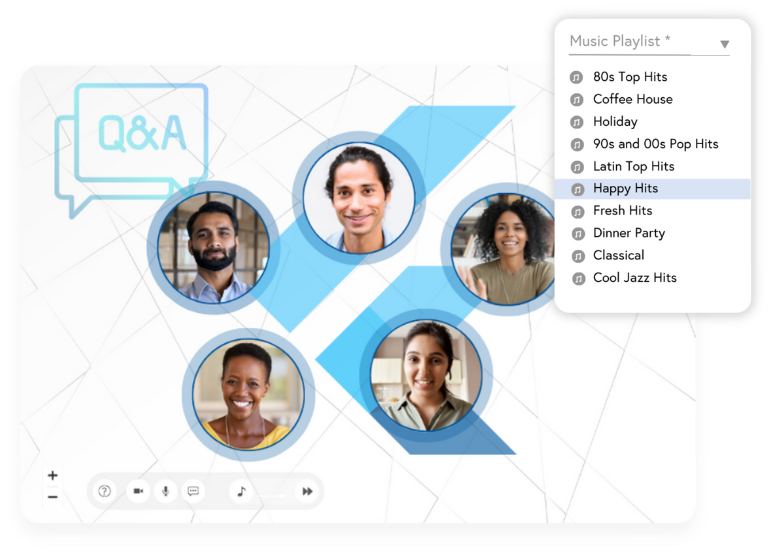While much of the white-collar workforce has adjusted to the new norm of videoconferencing from home, that doesn’t mean that they — or their bosses — necessarily like it. According to a poll from Showpad, 76% of employees report becoming more distracted on video calls versus in-person meetings. In a separate survey, staffers — especially new employees — say that requiring video during virtual meetings increases their work fatigue.
Ed Stevens thinks he has the answer. He’s the founder of Scoot, a platform that aims to reimagine video meetings with a dynamic chat interface. Previously known as Preciate, Scoot — which launched its new brand today — recently closed a $12 million Series A funding round led by Woodland Capital, bringing its total raised to over $16 million.
“Most CEOs in the world agree with this: virtual all-hands meetings hosted on static legacy platforms like Zoom and Microsoft Teams are terrible at replicating the energy and value of meeting in-person,” Stevens told TechCrunch in an email interview. “CEOs are dissatisfied with their virtual all-hands platforms and badly need something better.”
Scoot’s conceit isn’t new. The startup is one of dozens trying to reimagine videoconferencing for the post-pandemic workforce. Even prior to the pandemic, videoconferencing was a lucrative segment, with funding for videoconferencing startups hitting $250 million in 2017, according to Crunchbase.
Vowel, backed by Calendly CEO Tope Awotona, offers what it calls a “meeting operating system” with analytics and searchable on-demand recordings. Read AI provides a real-time shared dashboard to alert meeting participants when things are going well — or not so well. There’s also Venue, which brings in a host of personalization and other features — like emoji bursts, the ability to set background music and more — to attempt to make conferencing more engaging.
So how’s Scoot different? In some ways, it’s not. Like a few of its rivals, Scoot lets customers choose custom background themes and music for meetings. An admin can designate which features are available to participants and secure rooms with join settings. Meanwhile, hybrid meeting features allow users to livestream content into a virtual room joinable via Scoot’s iOS and Android mobile apps.

Admins also have access to analytics, like who attended a meeting and how long they attended. When asked whether Scoot stores this data indefinitely — an important question, considering the surveillance potential of videoconferencing apps — Stevens says that customers can choose to delete it at any time.
“Not only can you share a screen, run a Q&A session or DM someone in chat, but you can also move inside a 2D room, which has been decorated with your logo, colors and graphics,” Stevens explained. “Before, during and after the formal component of the meeting, attendees can find colleagues and customers, have sidebar conversations, and just be human.”
“At Scoot, we are redefining online virtual meetings, gatherings and networking,” Stevens continued. “Gone are the days of static images pinned to the screen. Scoot unlocks a new dimension for virtual meeting by replicating what happens when a group of people (small or large) gather together in person to network, share and discuss ideas. The upside is a level of engagement and productivity that resembles physical meetings, but with the flexibility, speed and cost savings of a virtual meeting.”
But Scoot does have more unique features, like “spontaneous conversations,” which lets meeting participants break out into smaller groups for more intimate chats. Stevens sees Scoot’s small groups functionality as particularly useful for larger organizations, where meetings can exceed hundreds or even thousands of attendees. Admins have some control over it, he notes, in the sense that they can purposefully “group” employees with other employees within the context of a larger meeting.
“Once you give people the social agency to move around in a big company meeting, you can … drive company goals. For example, you can make sure a senior leader is placed with each group of employees in the socially oriented arrivals and departures component of the agenda,” Stevens said. “Scoot unlocks a new dimension for virtual meeting by replicating what happens when a group of people, small or large, gather together in person to network, share and discuss ideas.”
Scoot’s other standout feature is what Stevens calls “crowd noise technology,” which lets a presenter — and rooms up to thousands of people — hear reactions (e.g. laughs, cheers) in real time. While perhaps not a massive selling point, Stevens argues that it makes meetings “more engaging and interesting” than they normally would be. (I’m not convinced that the average person is inclined to cheer during a virtual meeting, but perhaps I’m the odd one out.)
Scoot — which offers APIs developers can build on top of — makes money by charging access to its baseline service. Stevens wouldn’t disclose the size of Scoot’s customer base (or revenue), but said that the company counts several Fortune 50 businesses among its customers.
“The slowdown in tech has most of our competitors playing defense, right at the time when we are investing more,” Stevens said confidently. “From a financing perspective, Scoot’s existing investors have all the dry powder needed to fund future growth.”
On the subject, Scoot plans to grow its workforce from 14 people to more than 30 by the end of the year.































Comment